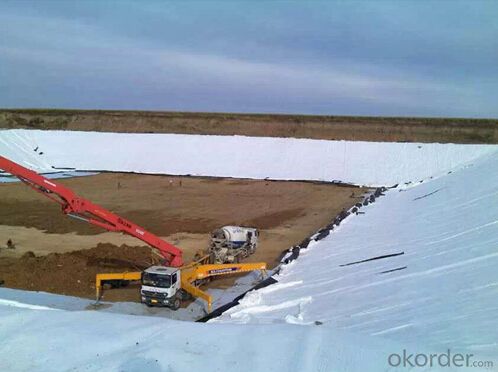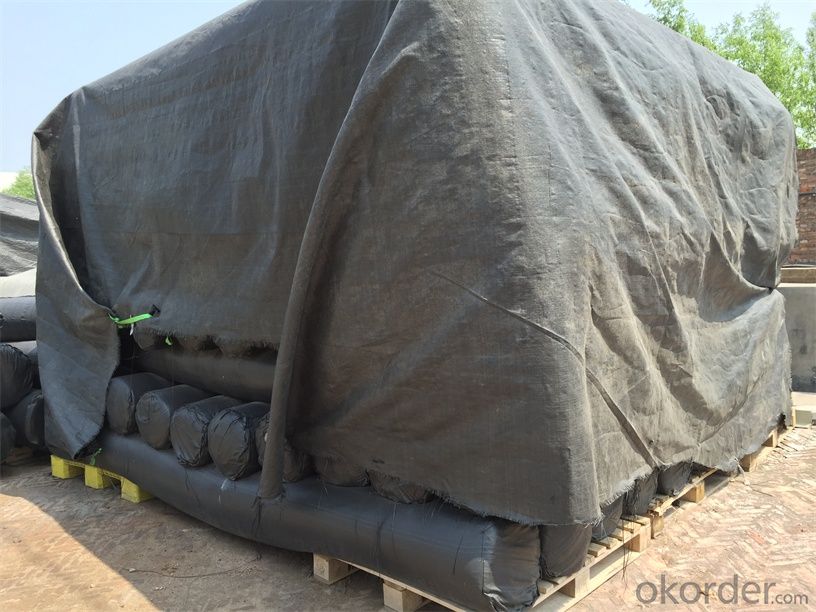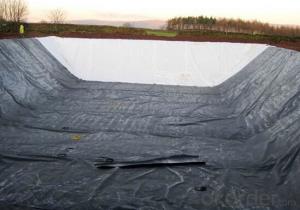Geotextile Filter Non Woven Polyester Geotextile
- Loading Port:
- Qingdao
- Payment Terms:
- TT OR LC
- Min Order Qty:
- 10000 m²
- Supply Capability:
- 30000000 m²/month
OKorder Service Pledge
OKorder Financial Service
You Might Also Like
Specifications of Geotextile
Needle-Punched Non-Woven Geotextile is a special kind of nonwoven geotextile because of its special manufacture method by puncturing the rolling formed layer made of randomly oriented short staple fiber. Our raw material is the top class 100% new PP(Polyproplylene ) or PET(Polyester) fiber. The needle punch process involves forcibly entangling layers of loose staple fibre into three dimensional structure by sequentially punching and pulling out barbed needles through the fiber matrix, and forms a strong fabric that retains its dimensional stability, expands the serving year to all the applied project. Because of its proven track record and versatility, Needle Punched, as the most commonly used Nonwoven Geotextile, is widely used in civil and environmental engineering applications like subsurface drainage, roadway separation, railroad stabilization, erosion control, hard armor underlayment, landfill leachate collection, underground retention/detention systems, environmental protection and other projects.
Application of Geotextile
1. Filtration
The filtration layer of the dykes, river canal, seacoast, concrete slope, retaining walls. At the same time of preventing the clay granule from passing, it allows the water and the gas pass through freely.
2. Separation
The isolation of the railway dregs and the roadbed, roadbed and the soft base, surface of the airdrome and parking lot and the groundsill, different dam materials. It isolates the soil and the gravel of two kinds different granule pathway from the groundsill or other buildings.
3. Reinforcement
The highway, railway, soilstone dam, breakwater, airport, backfill soil of retaining wall, slope protection, etc in which distributes the earth stress, prevents the side-displacement of the earth body and improves the earth body stability.
4. Protection
It prevents the bank from being washed out, protects the bank and the bottom, prevents the water and soil from being washed away.
Woven geotextile :
Made from polypropylene and or polyester fibers, manufactured with high tensile strength and low elongation, our woven geotextiles have superior properties for filtration, separation, reinforcement, erosion control and drainage. We are leader in providing woven geotextiles for a variety of civil and environmental applications including highways, port facilities, reservoir, transport construction, waste and chemical management ,subgrade engineering, coast reclamation works, peninsula shoal engineering.
Properties of Multifilament Woven Geotextile
Metric and British conversions:
1kn/m------around68.57lbs/ft 1oz/yd2---around 33.9g/m2 1m------around 3.3ft
Physical properties | Test method | Unit | Typical Value | |||||||
Material | Polyester/PET | |||||||||
Color | White | |||||||||
Tensile Strength at break MD | ASTM D 4595 | KN/M | 100 | 150 | 150 | 200 | 400 | 300 | 500 | 1000 |
Tensile Strength at break CD | ASTM D 4595 | KN/M | 50 | 50 | 150 | 50 | 50 | 300 | 100 | 50 |
Elongation at break MD | ASTM D 4595 | % | <=15< span=""> | |||||||
Elongation at break CD | ASTM D 4595 | % | <=15< span=""> | |||||||
Permitivity | ASTM D 4491 | S-1 | 0.01-0.8 | |||||||
Pore opening size O90 | ASTM D 4751 | mm | 0.06-0.7 | |||||||
Notes:
1)The property values listed are gained in our laboratories .The right is reserved to make changes without any notice
2)Mechanical properties, origin materials, width, roll length can be adjusted to different applications.
Geotextile Products Show:






\
FAQ:
- Q: What can we do for the special customer?
A: Provide custom made service with customer's drawing; We make sure to provide you with the best solutions for your individual case. Whether standard items or non-standard items.
- Q: What can we supply?
A: We provide high levels of communication from start to finish.
- Q: What is our advantage?
A: Top Cemented Carbide has extensive business experience, Fast delivery and high quality.
- Q: What are the ingredients of PL?
- I didn't expect to find my parents' Lin soon. I was very happy, and the thing he worried most about me didn't happen. However, in this environment, Lin Yun had to worry about the safety of his family.
- Q: What are sheep Beijing fabrics?
- I try not to wear with a hard object collision, so as not to hurt, don't wear when it rains, the rain touched the ground very difficult to take care of. If the first is dirty with shoe brush gently brush the surface dust, then use a damp cloth to wipe dirty place, such as dry and can be worn. In addition, nubuck leather shoes for a long time do not wear or wear long easy to change the color of old, then can go to the store and bought a special shoes to choose shoes with the same color, evenly coated on the shoes, the shoes will apply Oh, then the excess surface can be painted to shoes with shoe brush.
- Q: What are the popular clothing materials in the market now? How do you distinguish them?
- Twill fabric: warp and weft are woven at least once between two yarns, and the fabric structure is changed by adding warp and weft points, collectively referred to as twill.Fabric features: there are positive and negative points, a complete organization, the cycle of less weaving point, long floating line, soft feel, tissue fabric density is higher, the product is relatively strong, three-dimensional organization strong sense. There are 30 branches, 40 branches and 60 branches.Twill fabric classification: 40 twill fabric, printed fabric (activity of some businesses called flower satin, to illustrate the high-grade fabrics, but in fact he does not belong to the satin fabric), sanding fabric, satin fabric, jacquard fabric, cotton jacquard fabric, satin fabrics etc..
- Q: What is the Tencel fabric sanding
- Sanding fabric cotton fabric by Tencel fabric according to different organizations can be divided into three types of cloth, is mainly plain cloth, twill fabrics, satin fabric.
- Q: Who can tell me what kind of fabric peach is?!
- Juicy peach is a kind of flannel. It is called "peach skin""Peach is the product after product development after suede leather fabric, which is composed of a thin microfiber fabric. The dyeing and finishing process of fine grinding and finishing, the fabric surface tightly covering about 0.2 mm short, likethe surfaceofthepeach, withanoveland elegantappearance andcomfortable feel, so favored by people, so the name of the fabric for peach (peachskin). Thus, the nap finishing is also called "peach skin finishing"". This is similar to that of suede finishing, which is also known as suede finishing when suede products are in fashion.
- Q: What are active fabrics and semi active fabrics, please?
- Semi active printing is also called semi active dyeing and printing. Semi active dyeing and printing is not adding azo and formaldehyde in the process of dyeing and printing, and it does not contain substances harmful to human body, and it doesn't fade or shrink when washing. The difference between the activity of printing and dyeing and coating printing and dyeing of reactive dyeing of soft feel slippery, the common argument is that the reactive dyeing of mercerized cotton fabric looks like, from the two aspects of positive and negative view of dyeing effect is very good; and the paint dyeing fabrics feel stiff, looks a bit like the ink painting effect.
- Q: What's the difference between knitting cotton and pure cotton?
- In fact, cotton and knitting cotton is not much difference. Knitting cotton is a fabric made of cotton through the machine. Therefore, it is very healthy and has no harm to the body. Two kinds of fabrics have certain advantages, but also has certain shortcomings. The disadvantage of knitting cotton is that the warp and weft of fabric is larger, and there is no good warmth of cotton. However, its dyeing process is very good, but cotton is shrinking more serious, and easy to deformation, and to really say both of which is better, but also according to their preferences to decide.
- Q: How to choose dress fabric?
- If you want to buy a good lace, you should first touch the softness of the lace fabric, which is the most important. In addition, carefully observe whether the process is consistent, flowers, three-dimensional sense of the delicate degree, to ensure that there is no defect. The best fabric contains a little spandex (elastic) components, increase the flexibility of fabrics, lace fabric with these characteristics as the top grade.
- Q: What kind of fabrics are shirts and blouses?
- Belongs to the cotton quality, but has the ingredient difference, the shirt generally is not the real significance cotton.
- Q: Excuse me, chemical fiber, blending and polyester is not very different, if you choose these two kinds of clothes as the main fabric, which is good?
- For example, polyester / cotton blended fabric is made of polyester fiber. It is made of 65%-67% polyester and 33%-35% cotton blended yarn. The polyester cotton fabric, commonly called cotton, is really cool. Features: not only highlights the polyester and cotton fabric style strengths in dry and wet conditions and better flexibility and abrasion resistance, dimensional stability, small shrinkage, with tall and straight, not easy to fold, easy to wash, dry, not with high iron and soaked in boiling water.
Send your message to us
Geotextile Filter Non Woven Polyester Geotextile
- Loading Port:
- Qingdao
- Payment Terms:
- TT OR LC
- Min Order Qty:
- 10000 m²
- Supply Capability:
- 30000000 m²/month
OKorder Service Pledge
OKorder Financial Service
Similar products
Hot products
Hot Searches
Related keywords


































